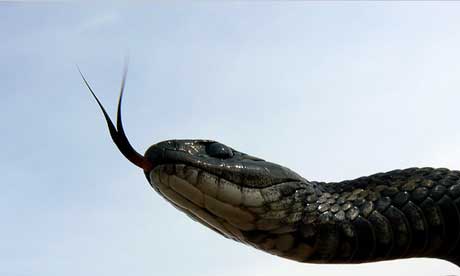
There are almost 3,000 species of snakes on the planet – Here we look at the likelihood of being bitten, and what you should do if you are
Snakes are almost universally feared.
They get a very bad press, which is perhaps why some travellers mistakenly believe it better to stock up on poison-sucking devices than rehydration salts. The good news, though, is that most snakes are non-venomous. Of nearly 3,000 snake species on earth, around 500 are venomous and only about 250 have ever caused deaths or permanent disability. Venom is energy-expensive for snakes to dispense.
It is their means of catching food so most will avoid using it on a non-food item such as a human; perhaps half the bites delivered by highly venomous snakes are ‘dry’ – no venom is dispatched.
All in all the chances of receiving a dangerous bite are very small. Australia, for example, has many venomous species yet few cause death. The people of South India – where cobras live – fear scorpions over snakes.
Anyone venturing into snake country should be properly dressed in long trousers and stout footwear. This is especially important if undergrowth or scrub obscures your view of the ground, although snakes – being hunters – are masters of camouflage. I recall stopping to photograph a beautifully marked viper that was sunning itself on a narrow path in a Sri Lankan forest. Two people walking ahead of me had both narrowly missed stepping on it; as they were wearing shorts and sandals, they also narrowly missed being bitten.
People most likely to get bitten are those that unwittingly disturb a snake, or tease one. Watch where you are putting your hands when collecting firewood or moving logs. And think twice before trying to stimulate a snake into activity – animals that are playing possum may not be interesting to watch or photograph, but provoke them at your peril.
Snakes are most active from dusk throughout the night – so always carry a light. For most species their favourite foods are rats and mice; this means that they are attracted to grain stores or other places where rodents forage, so keep your living and sleeping area clear of scrub and old food. Also, sleep off the ground (in a hammock or camp bed) and under a mosquito net or in a tent with an attached groundsheet.
Snake classification is a muddle and even the experts seem to disagree. Some suggest deciding whether a snake is venomous by looking into its eyes, but unfortunately this isn’t a very reliable method. However, the dangerous species break down into three main groups.
Elapids Widespread in the tropics
Their pupils are often vertical; venom is usually neurotoxic (harms nerves). Species include cobras, mambas, kraits, taipan, death adder, coral snakes, sea snakes and Australian copperheads.
Viperids Found worldwide except Antarctica and the oceans
Pupils elliptical; venom is usually tissue-destructive. Species include vipers, pit vipers, European adders, copperheads, rattlesnakes and bushmasters as well as the fer de lance (pictured).
Colubrids Worldwide except at cold latitudes and altitudes
Pupils horizontal or vertical elliptical; many are non-venomous or back-fanged so incapable of biting. Species include boomslangs, tree snakes, vine snakes, mangrove snakes, egg-eaters and American water snakes.
Sea snake and Australian snake toxins digest muscle and the breakdown products overwhelm the body and/or affect heart rhythms. This is a particularly horrible toxin, although sea snakes are rarely interested in biting people – most commonly they attack fishermen who have hauled them out of the sea by mistake. It is also possible to anger sea snakes if you swim or snorkel into one of their sexual orgies, recognised by a writhing mass of bodies. Feared kraits and bushmasters are also rather placid snakes and don’t have the temperament to bite – unless seriously provoked.
These include bleeding from the bite marks, bleeding gums, convulsions, drowsiness, drooping eyelids, paralysis and muscle pain. Victims should be placed under clinical observation for 24 hours.
Applying a tourniquet after a viper bite will probably worsen the effects of the venom. Slowing spread of venom after a cobra, krait, mamba, coral snake, sea snake or Australian snake bite can be life-saving, but the safest way of doing this is by splinting and/or compression bandaging rather than applying a tourniquet.
Try to keep calm – panic will make matters worse. Write down the time of the bite so you can monitor the speed of onset of any symptoms. Look at the bite – if the wounds are two rows of teeth marks, the bite is from a non-venomous snake; two puncture wounds may indicate a venomous reptile. Try to identify the snake if safe to do so.
Do NOT – cut into the bite Use suction apparatus (eg Venom-ex) or apply an ice pack . Tourniquets are rarely recommended.
Keep the bitten part immobile It should be below heart height to slow venom spread and remove any jewellery or tight clothing from the site of the bite.
Consider bandaging Apply a broad, firm crepe bandage around the bite and splint it to keep it still; this must be released every 30 minutes to let blood reach the body tissues.
Evacuate Get to somewhere with anti-venom as quickly as you possibly can.